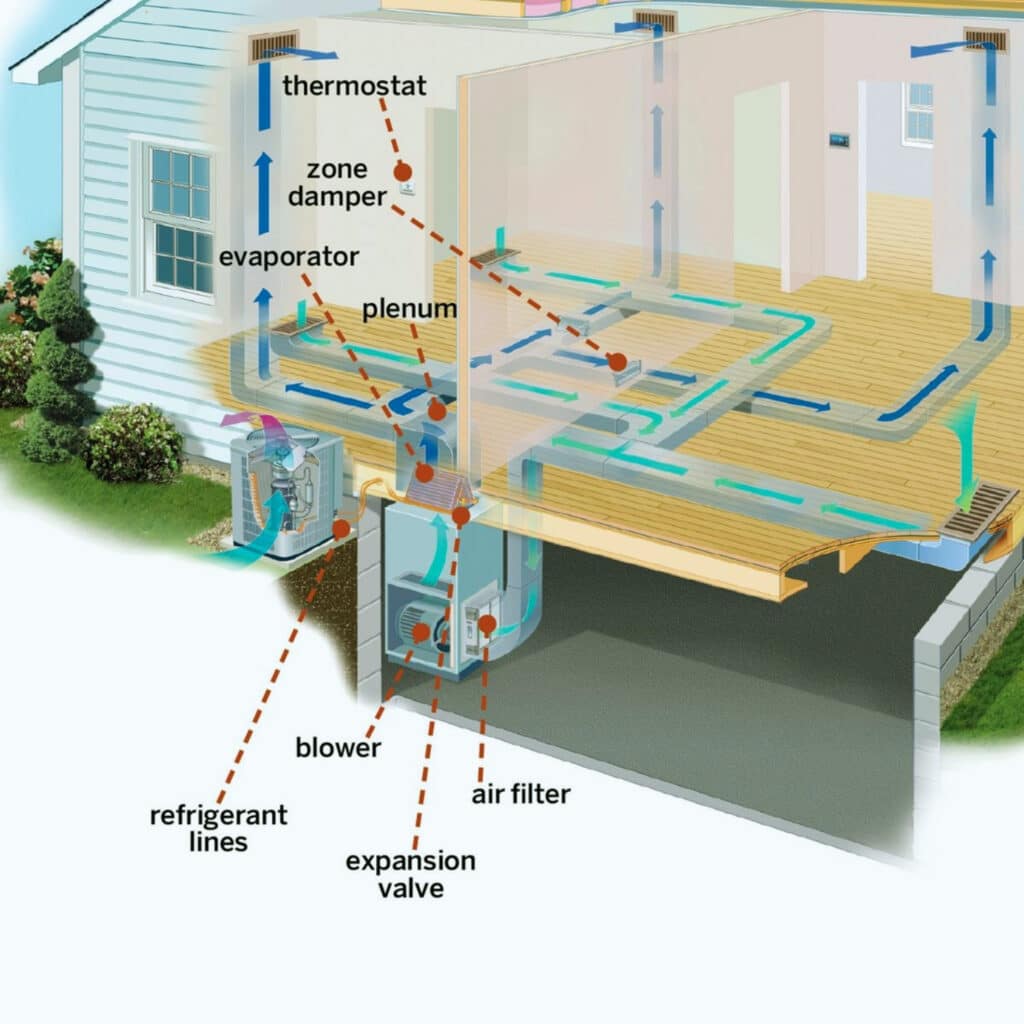This post are formulated to help you diagnose the cause for an AC leaking water and perhaps even solve your problem without a service call.
When your air conditioner is running, and you discover water in your basement, seeming to come from the furnace, it’s not a problem that you can ignore. If you have a finished basement, the water will continue to accumulate and damage your furniture as long as the air conditioner is running. And if the water is dripping through the inside of the furnace on its way down, this is a problem that requires immediate attention.
How Air Conditioner Removes and Disposes of Your Home’s Humidity
Some of the benefits and most of the comfort of central air conditioning come from removing humidity from the air.

When the air passes through the furnace, it goes through the evaporator coil. The evaporator coil is sealed into the sheet metal above your furnace.
It looks somewhat like a car radiator, and it’s where your outdoor air conditioning unit delivers the cooling. As the air is cooled, the humidity from the house air is condensed into liquid water.
The same principle which forms drops of water on the outside of an iced tea glass on a warm, humid day in Summer.
However, the condensation in an air conditioning system occurs on a much larger scale and produces gallons of water, which must be disposed of. When everything’s working right, the water collected on the coil surface drips down into a rain-gutter pan under your evaporator coil.
This pan is equipped with a drain fitting, which feeds out the side of the furnace, travels through a drain hose, and exits down your floor drain. If the floor drain is not used, the furnace is equipped with a condensate pump.
But, sometimes, the water ends up on the floor, and that’s where we don’t want it. Depending on how adventurous you feel, there are a few things that the homeowner can check without any specialized tools or training to better diagnose and perhaps solve the problem of misdirected water.
Diagnosing the Source of an Air Conditioner Water Leak
Take a moment and a good strong flashlight, and see if you can tell where the water is coming from and what route it is taking to get to the floor.
Does the furnace leaking water when ac is on? If the source of the water leakage is not obvious, check first inside the upper cabinet of the furnace. Remove the upper panel of the furnace, being careful not to touch any of the components inside.
Is there an accumulation of water inside the cabinet? It should be dry in there!
Suppose it is not – if there is an accumulation of water, or a drip, condensation, or anything having to do with moisture inside the furnace cabinet. Turn the furnace OFF before further damage occurs.
Water is the enemy of all things electronic, and if your circuit boards get wet, damage can be extensive and expensive. So, if there’s water inside the furnace cabinet, turn off the furnace (using the light switch on the side of the furnace or at your home’s circuit breaker panel) and CALL a professional HVAC technician immediately.
If there is no immediate danger to the sensitive components inside the furnace, perhaps there is something you can remedy yourself.
Air Conditioner Leaking Water from the Drain Pan
Does the water seem to originate at the point where the bottom of the galvanized sheet metal meets up with the top of your furnace and then run down the side of your furnace? One cause for this could be a blockage in the hose or the drain fitting of the pan.
Try a few of the following steps, and you’ll get a better handle on what is – and isn’t – causing the water backup.
Squashed Hose
Isn’t that embarrassing when the HVAC technician comes out to look for a water leak, and you find that box of Home and Garden magazines parked right on top of the hose, right where you put it – squashing it down so that the water backs up! Put them somewhere else – maybe you should build another shelf in the basement.
Drain Hose Air Lock
Take a look at the discharge end of the hose – the end where the water is supposed to come out. Is it submerged? That is, does it go down into the drain and end up underwater?
Did you know that just one air bubble in the drain line will prevent water from flowing out of that hose? The water that is already in the drain seals off the water trying to come down – it’s called an Air Lock.
It’s science, and it will cost you the price of a service call if you have to have a professional pick up the hose out of the water.
Be sure that the hose ends before it enters the drain (Cut it off so you can keep an eye on the end.) And make sure that the discharge end of the hose is not underwater.
Water Runs Downhill
The passage of the hose from the furnace to the drain should be continually downhill. Water is not going to run uphill, even for a short distance.
We assume that if the hose was once working, it was properly placed. But if you have recently moved the hose, so it takes a different route to get to the drain, you have only to look in the mirror to see who the culprit is. If the hose tries to run the water uphill, it could form an airlock (see above) or simply not run at all.
Clogged Drain Line (Hose)
When the home’s air passes through your furnace, sometimes it leaves behind small amounts of dust, pollen, and general household air dreck. When the condensation from the air conditioning process passes through the hose on its way to the drain, there can be a buildup of this solid material.
Mold, mildew, and algae buildups are also possible inside the hose, which can clog the drain line.
Some groups of symptoms point to a clogged drain line. If the air conditioner is running normally, but no water is coming out of the end of the hose, or if there is water coming down the side of your furnace, sometimes all that is needed is to unblock the clog from the hose.
Here are some things you might want to try on your own to fix the AC leaking water and possibly to save the cost of a service call:
- Be sure that there are no kinks in the hose impeding the water flow.
- Once again, check the placement of the hose. Every foot should be running downhill, not just the end by the drain. Water runs downhill. Are you the one who moved the hose, and now it runs partly uphill?
- Moving all along the hose route, from fitting to drain, squeeze the hose with your fingers to loosen any accumulated debris. It’s like massaging a python, but it won’t bite.
- If you have an air compressor, blow some compressed air into the discharge end with your air hose, and GET OUT OF THE WAY after releasing because if you dislodge the clog, the backup will drain out of the hose very fast.
- The following is something we heard from homeowners, but wouldn’t personally recommend, for aesthetic reasons. Grasping the discharge end of the drain hose firmly, blowing into the hose, then putting it quickly down onto the drain. I’d rather be blowing on a trombone. Have some mouthwash handy if you try this one, and remember, you didn’t hear it here.
- Disassembly of the hose. Detaching the hose from the fittings, there are many options to explore, for instance, probing gently into the fitting with a pipe cleaner or other soft wire replacing suspect sections of the hose. This may solve your blockage problem.
Leaky Drain Line
If there is a hole in the drain line due to the age or something that was moved across the hose, puncturing it, the hose section should be replaced.
When replacing hose sections, be sure to get a BLACK hose and not the clear variety. The clear hose tends to act just like a little greenhouse, and algae thrive inside the warm, moist interior of the drain hose, causing eventual clogging.
Leaky Drain Fittings
Check the fittings wherever the hose fits onto an elbow, coupler, or drain pan fitting. The hose should be securely pushed fully onto the fittings, and there should be no water leakage evident.
If there is leakage, and the hose doesn’t seem to be the water source, perhaps there is a cracked fitting. You can get new fittings at many hardware stores. Bring the old fitting with you to get an exact size match.
Condensation on the Furnace Plenum
When your air conditioner is operating, the air is cooled in the plenum space above your furnace. That’s where the outdoor unit delivers the cooling to an evaporator coil through which passes the air from your house. Considering this, it is normal for the furnace plenum (the metal part above your furnace) to be cool to the touch.
Sometimes, if there is enough moisture in the basement air, there can be condensation on the outside of the furnace, and if there is enough accumulation, it will run down the sides of your furnace and onto the floor. This problem is not due to the air conditioner leaking water; the water is coming from the air in the basement, not from within the furnace.
This same condensation can occur on the copper pipes, which lead from the furnace to the outdoor air conditioner (these are also called tubes, lines, lines, etc. refrigeration nomenclature is not always standard.)
Water on these pipes is also from the air in the basement – there is no water inside of these tubes that can leak out, and a leak in one of these copper lines is a major problem that the homeowner can’t fix. So be careful around these copper pipes.
Condensation on the furnace is brought under control by controlling the humidity in the basement. If your basement area is not air-conditioned, you may consider running a dehumidifier in the basement. If the air is dry, the condensation will be minimized.
Does your air conditioning seem to be blowing out the registers with less force than usual? Then the answer of why my Air Conditioner leaking water could be due to an ice block forming in the plenum of your furnace.
Conclusion
Air Conditioner leaking water can come from several diverse causes. Some of these problems can be diagnosed and rectified simply. In other cases, the water is a symptom of a greater problem that has to be solved by a professional technician.
Now you know all the causes that could lead to an AC leaking water. And the best way to prevent it is to get your system regularly maintain.






